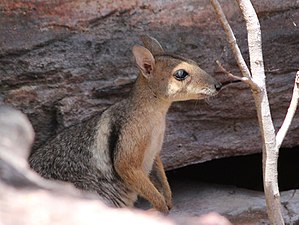Wilkins rock kangaroo
| Wilkins rock kangaroo | ||||||||||||
|---|---|---|---|---|---|---|---|---|---|---|---|---|

Wilkins Rock Kangaroo, photo from Kakadu National Park |
||||||||||||
| Systematics | ||||||||||||
|
||||||||||||
| Scientific name | ||||||||||||
| Petrogale wilkinsi | ||||||||||||
| Thomas , 1926 |
The Wilkins rock kangaroo ( Petrogale wilkinsi ) is a species of marsupial from the kangaroo family (Macropodidae).
distribution
It is native to the Northern Northern Territory and occurs there from the Daly River in the west to Wollogorang on the border of the Northern Territory with Queensland . There are also populations of the species on Groote Eylandt , Bickerton Island , the Sir Edward Pellew Islands and the Wessel Islands .
features
Female Wilkins rock kangaroos reach head body lengths of 31 to 47.3 cm, males are significantly larger with 37.5 to 57 cm. The tail is about the same length in the females (29.7 to 52 cm) and in the males (31.2 to 51.7 cm). The weight of the females is 2 to 4 kg, that of the males 2 to 5 kg. The Wilkins rock kangaroo has a dark gray to brownish gray, sometimes yellow-brown back and a lighter or whitish belly. Like many rock kangaroos, Wilkins rock kangaroos have noticeable stripes or patterns on their body. They show a distinct black and white, sometimes black and yellow shoulder stripe and a light stripe on the flanks and hips. The color of the limbs is clearly different from the body color. They are yellowish, orange or reddish brown. The face is light brown to orange brown. The tail is lighter in color than the back, the sides of the tail are more yellowish. The tail becomes increasingly darker towards the rear. The last third to the last fifth are brown-black.
The Wilkins rock kangaroo occurs in varied rocky areas with cliffs, gorges and steep slopes and avoids the plains in between, which is why the individual populations are largely isolated from one another. It is therefore very diverse genetically and in terms of color. Within the species, the mitochondrial DNA differs as much as between different rock kangaroo species (up to 12%). On the Roper River , the animals are more yellowish, including a yellowish shoulder stripe. On Groote Eylandt they are rather dark, silvery gray. The shoulder stripe is gray-black, the back stripe is very dark and wide. It widens into an irregular dark spot on the head. In the southern Gulf of Carpentaria , including the Sir Edward Pellew Islands , the Wilkins rock kangaroos are generally lighter, more brownish, sometimes reddish, and have less conspicuous patterns. The face and tail are often darker.
The Wilkins rock kangaroo differs from the dwarf stone kangaroo ( Petrogale concinna ), which occurs in the same area , primarily in its larger size, different karyotype and different mitochondrial DNA . The Wilkins rock kangaroo is smaller than the short-eared rock kangaroo ( Petrogale brachyotis ), it is darker and more brownish than its relative. The stripes or patterns are more evident. The arms contrast more conspicuously with the color of the body than in other populations.
Way of life
The Wilkins rock kangaroo is found in rocky areas within tree savannahs and monsoon rainforests. It feeds on plants, preferring grass, which is mostly eaten during the rainy season. It also eats seeds and fruits, and according to Aborigines it also eats the native yams ( Dioscorea transversa ). Little is known about reproduction. Females get a single cub. Reproduction takes place all year round, there does not seem to be a specific reproductive time. The Wilkins rock kangaroo is even nocturnal in the hot season of the twilight. It spends the day asleep hidden between the rocks and leaves its hiding place in the late afternoon or early evening to feed. It is up to 500 meters away from the last sleeping place. On cool days, the animals sit on rocks to sunbathe. An individual can use up to seven different sleeping places in his area. The size of the territory that a single animal inhabits can be up to 17 ha. The territory broadly overlaps with those of neighboring individuals and is usually larger in the dry season than in the rainy season. Females are philopatric , while young males are more likely to migrate.
Systematics
The Wilkins rock kangaroo was first described in 1926 by the British zoologist Oldfield Thomas . Eldridge and Close synonymized the species in 1997 with the short-eared rock kangaroo ( Petrogale brachyotis ). In 2014, the Wilkins rock kangaroo was revalidated after DNA comparisons with the Kimberley rock kangaroo ( Petrogale burbidgei ), the dwarf rock kangaroo ( Petrogale concinna ) and the various lines of the short-eared rock kangaroo.
Individual evidence
- ↑ a b c d e Potter S., Close RL, Taggart DA, Cooper SJB and Eldridge MDB 2014. Taxonomy of Rock-Wallabies, Petrogale (Marsupialia: Macropodidae). IV. Multifaceted Study of the brachyotis group identifies additional taxa. Australian Journal of Zoology. 62 (5) 401-414. doi: 10.1071 / ZO13095
- ^ Mark Eldridge & Graeme Coulson: Family Macropodidae (Kangaroos and Wallabies). Page 709 in Don E. Wilson , Russell A. Mittermeier : Handbook of the Mammals of the World - Volume 5. Monotremes and Marsupials. Lynx Editions, 2015, ISBN 978-84-96553-99-6
- ↑ Thomas, O. (1926a). Two new rock-wallabies ( Petrogale ) discovered by Capt. GW Wilkins in northern Australia. Annals & Magazine of Natural History 17, 184-187. doi: 10.1080 / 00222932608633389
- ^ Eldridge, MDB, and Close, RL (1997). Chromosomes and evolutionin rock-wallabies, Petrogale (Marsupialia: Macropodidae). Australian Mammalogy 19, 123-135